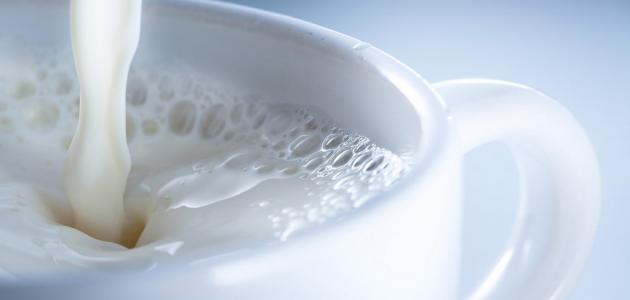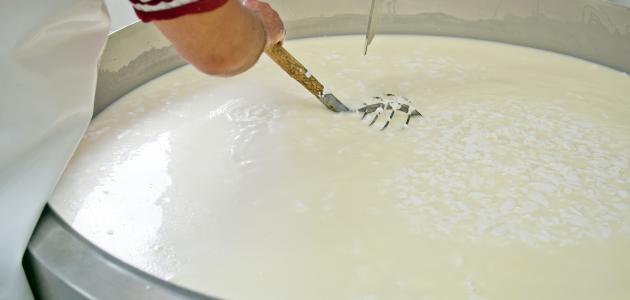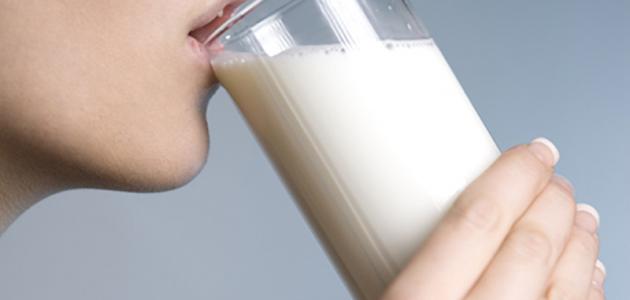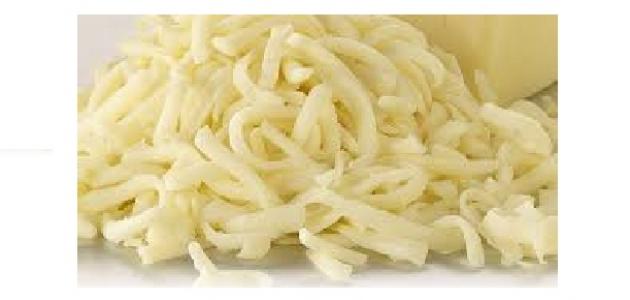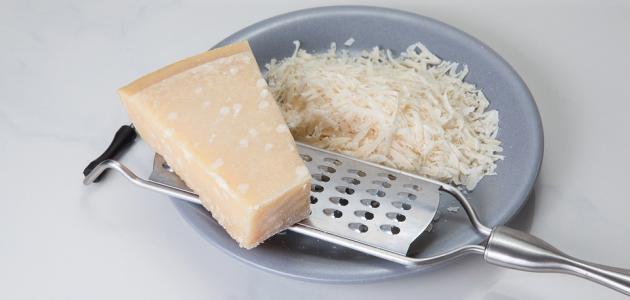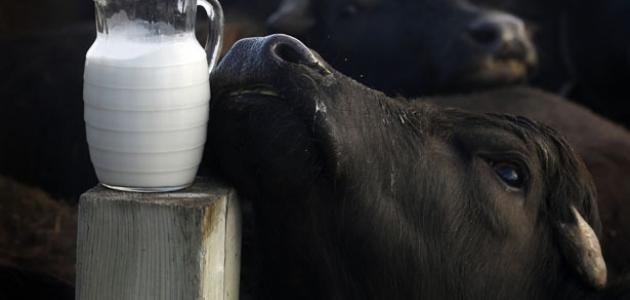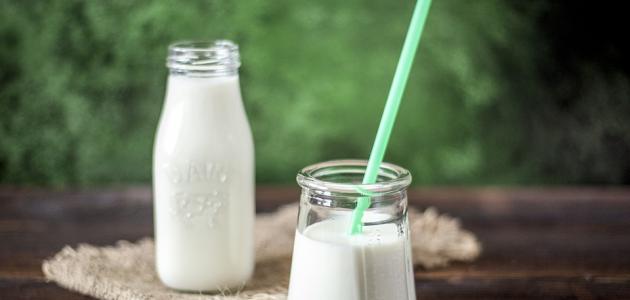Contents
the milk
All mammals, including humans, produce milk, which is a white liquid secreted by the mammary glands, and it contains nutrients useful for feeding infants, until they are able to eat solid food, [1] as it contains many vitamins and minerals, the most important of which is calcium, so it is recommended By consuming milk and dairy products, such as cheese, and yogurt daily as part of a balanced diet. [2]
The benefits of milk for the body
Milk's nutrient content
Milk is a source of many vitamins and minerals, such as calcium, vitamin D, vitamin B12, potassium, vitamin A, zinc, magnesium, and vitamin B1, in addition to being an excellent source of protein and hundreds of different fatty acids, including omega-3 and linoleic acid Conjugated linoleic acid, and below is a breakdown of the nutrients in milk: [3]
- Rich source of high-quality protein : Milk contains protein that is necessary for many vital functions in the body, such as growth, cell restoration, and immune regulation, as milk is a complete protein, because it contains all the nine essential amino acids that the human body needs to perform its functions properly. Increased consumption of milk and dairy products by increasing muscle mass, improving athletic performance for the elderly, and promoting muscle healing in athletes, in addition to reducing muscle damage and pain after exercise. [3]
- A rich source of fatty acids: milk contains 400 different fatty acids, which make up 70% of saturated fats in whole milk, and monounsaturated fats 28%. Polyunsaturated fats constitute 2.3% of the fat content in milk, in addition to the availability of trans fats naturally in dairy products, which are beneficial to health in contrast to the trans fats available in processed foods Trans fats in milk are made of Vaccenic acid and Conjugated linoleic acid, which are likely to have health benefits for the body. [4]
- A high source of calcium: Calcium is one of the most important minerals for the human body, and the most abundant in it, as it helps to form bones and teeth, and maintain their health, in addition to containing calcium in nerve cells, body tissues, fluids, and blood, and the appropriate level of calcium is also associated In the body, it reduces the risk of osteoporosis with age, and among its benefits also is that it helps to send and receive nerve signals, secrete hormones and other chemicals, and maintain the nature of the heartbeat, in addition to its role in muscle contraction and relaxation, and blood clotting. [5]
- High source of vitamin D: often supports milk and dairy products with vitamin D , which is common, and is mandatory in some countries, with one cup of milk fortified with vitamin D containing 65% of the recommended daily amount out of this vitamin. [4]
- A high source of vitamin B12: Dairy products are one of the sources of vitamin B12, or what is known as cobalamin, which is dissolved in water, which has an essential role in the processes of metabolism in cells, the formation of red blood cells, and the production of chromosomal DNA And nerve functions. [6]
- A high source of potassium: Potassium is known to be an essential mineral in the body, and it is one of the electrolytes, such as calcium and sodium, that is, it regulates the amount of fluid in the body, as it transports nutrients into cells and wastes outside of them, and is essential for the body's organs to perform Its functions including the heart, brain, muscles, and nerves, in addition to its role in regulating blood pressure with the mineral sodium. [7]
- A high source of vitamin A: Vitamin A helps to form healthy teeth, soft tissues, and skeletal tissues, as well as mucous membranes and skin, and maintain them. Vitamin A is one of the fat-soluble vitamins, and it is stored in the liver. It is worth noting that it is also known as Retinol, because it produces pigments in the retina of the eye. [8]
- A high source of zinc: Zinc helps the immune system perform its functions in the body, has a role in the metabolism process, and is important for wound healing, the sense of taste, and smell, and it is a mineral available in all parts of the body, [9] in addition to that it supports healthy growth During the stages of life, so it is necessary during pregnancy and childhood, and zinc helps the formation of the pigment DNA and protein in the body. [10]
- A high source of vitamin B1: Vitamin B1 is one of the B complex vitamins dissolved in water, and it helps the body use carbohydrates to produce energy, and it is also necessary for the health of the brain, nervous system , and muscles, in addition to its importance for growth and cell functions in the body. [11]
- A high source of magnesium: Magnesium is an important and necessary mineral for more than 300 biochemical reactions in the human body, as it is essential for nerve and muscle functions, in addition to calcium, and the body also needs it to produce energy, to maintain bone and heart health, and to regulate blood sugar levels , As well as regulating blood pressure. [12]
- A high source of choline: , which is an important nutrient for sleep, memory, and learning, in addition to muscle movement, milk is a source rich in choline, which helps transport nerve cells, maintain the structure of cell membranes, and helps absorb fats, and reduce Chronic infections. [1]
Milk benefits according to the strength of scientific evidence
Benefits possess strong scientific evidence
- Promote bone health: The consumption of milk and fortified dairy products is associated with high bone mineral density, as well as strengthening and increasing bone mass, as milk contains the essential elements for building and strengthening bones, which include calcium and phosphorous, and when milk is fortified with vitamin D, this helps the body To absorb more calcium, which is necessary to prevent osteoporosis, [13] a comprehensive analysis published in The American Journal of Clinical Nutrition in 2017, including 26 studies, showed that increased protein consumption could protect the bone mineral density in the lumbar spine. [14]
Benefits have less strong scientific evidence
- Potential for lowering blood pressure: A study published in Current Cardiovascular Risk Reports in 2011 indicated an inverse relationship between consumption of milk and dairy products and blood pressure, due to the availability of a group of beneficial nutrients in milk and dairy products such as calcium, vitamin D, phosphorus, and potassium. Which may improve blood pressure and reduce the risk of developing high blood pressure. [15]
- Help curb appetite: Eating milk and low-fat dairy products helps to obtain whey proteins (Whey) and casein, which help curb appetite , [16] according to a study published in the European Journal of Clinical Nutrition in 2012 led to the fact that drinking milk lowered energy intake at a later time, compared to consuming drinks containing only whey or casein. [17]
- Reducing the risk of heart disease: Increasing potassium intake from natural sources, including milk, and reducing sodium consumption are associated with reducing the risk of cardiovascular disease, as potassium promotes blood vessel expansion, reduces blood pressure, and in contrast, an excessive increase in potassium levels would They cause some heart problems, so it is important to consult a doctor before changing the diet or consuming nutritional supplements, [1] and a preliminary study published in the Journal of Epidemiology and Community Health in 2005 showed that people who drank a large amount of milk had a lower risk of infection. Heart disease, and stroke. [18]
- Reducing depression: fortified milk is one of the sources of vitamin D, and this vitamin can positively affect mood, as it increases the monoamines neurotransmitters in the brain, as low levels of vitamin D may lead to feelings of depression, ( 19] A preliminary study published in the Journal of Social Psychiatry and Psychiatric Epidemiology in 2017 indicated that increasing the consumption of low-fat dairy products reduces symptoms of depression . [20]
- Reducing the risk of colon and ovarian cancers: Vitamin D in milk can regulate cell growth and reduce the risk of cancer, and this was confirmed by a study published in The Lancet in 2001, which also showed that the risk of dying from colon and rectal cancer increases in geographical areas that Not getting enough sunlight. [21] In addition, the National Cancer Institute has indicated that increasing calcium and lactose intake from dairy products helps reduce the risk of ovarian cancer. ). [1]
- Reducing the risk of osteoarthritis of the knee osteoarthritis: A study published in Arthritis Care & Research in 2014 showed that more frequent consumption of milk is associated with a lower progression of the knee osteoarthritis problem in women, and this is indicated by a study published in Arthritis Care & Research 2014. [22]
- Likelihood to reduce the risk of type 2 diabetes: A diet rich in low-fat dairy products may reduce the risk of developing type 2 diabetes, [23] and a preliminary study published in The Journal of Nutrition in 2011 indicated that eating a rich diet With low-fat dairy products by post-menopausal women who are obese, it may reduce their risk of developing type 2 diabetes. [24]
- Reducing the risk of obesity: A preliminary study published in The American Journal of Clinical Nutrition in 2016 indicated that consumption of dairy products may reduce weight gain in middle-aged and elderly women who were of normal weight. [25]
The benefits of milk for the teeth
Drinking milk promotes healthy teeth and bones, as the calcium in it helps the development of healthy teeth in children, and it is worth noting that the lactose available in milk is the least harmful to teeth. [26] A study published in Scandinavian Journal of Nutrition in 2002 indicated, He added that milk and dairy products reduce the risk of tooth decay , thanks to a group of elements available in them, including casein protein and peptides, in addition to the peptides in whey , which reduce Mineral loss from dental tissue. [27]
Benefits of milk for children
Milk is rich in many nutrients that are important for the healthy development of children, including: calcium, protein, vitamin B12, phosphorous, and other nutrients. [28]
To read more about the benefits of drinking milk during childhood, you can refer to the article on the benefits of milk for children .
The nutritional value of milk
The following table shows the nutrients available in 100 grams of whole milk, low-fat milk, and skimmed milk: [29] [30] [31]
| Element | Whole milk | Low-fat milk | Skimmed milk |
|---|---|---|---|
| Calories (kcal) | 61 | 50 | 34 |
| Water (milliliter) | 88.13 | 89.21 | 90.84 |
| Protein (grams) | 3.15 | 3.3 | 3.37 |
| Fat (grams) | 3.27 | 1.98 | 0.08 |
| Carbohydrates (grams) | 4.78 | 4.8 | 4.96 |
| Lactose (grams) | 5.05 | 5.01 | 5.09 |
| Calcium (milligrams) | 113 | 120 | 122 |
| Magnesium (milligrams) | 10 | 11 | 11 |
| Phosphorous (milligrams) | 84 | 92 | 101 |
| Potassium (milligrams) | 132 | 140 | 156 |
| Sodium (milligrams) | 43 | 47 | 42 |
| Selenium (μg) | 3.7 | 2.5 | 3.1 |
| Folate (μg) | 5 | 5 | 5 |
| Vitamin A (international unit) | 162 | 102 | 204 |
Damages to milk
Milk Consumption Cautions
Caution should be exercised when consuming milk in some cases, which include the following: [32]
- Lactose intolerance: The consumption of milk may cause some problems for people who suffer from lactose intolerance, whose symptoms are bloating, diarrhea, gas, and cramping, and the severity of these symptoms ranges from mild to severe, and in this case they must Eat dairy products with a low lactose content, such as Greek yogurt, and aged cheeses, such as mozzarella, cheddar, and Swiss cheese, or they can consume cereals containing lactose-digesting enzymes, with meals containing milk or dairy products.
- High in saturated fats: Dairy products are rich in saturated fats, the consumption of which is linked to an increased risk of heart disease, and despite the presence of many dairy products without saturated fats, many of them remain, such as ice cream, butter, and baked goods.
- Increased risk of some types of cancer: Milk contains the hormone estrogen, which is likely to increase the risk of breast cancer, prostate cancer, and testicular cancer. This problem appears as a result of feeding cows with synthetic hormones and antibiotics, which causes the hormones to increase in Milk, as the organic milk from grass-fed cows contains a high percentage of hormones, so skim milk is considered to have a lower content of hormones due to its availability in fat. [33]
What is the harm of drinking milk without boiling
Raw or unpasteurized milk is known as the milk produced from cows, sheep, goats and other animals without subjecting it to the pasteurization process to kill harmful bacteria in it, and therefore consumption as milk or even eating foods that make up it may be linked to the risk of infection with various types of bacteria, such as: salmonella and E. Coli, Listeria, Campylobacter, and others that cause foodborne illness, which is also called food poisoning, and these bacteria seriously affect health, especially for those with a weak system Immunomodulatory symptoms such as children, pregnant women, the elderly, and among the symptoms associated with this poisoning ; Vomiting, diarrhea, abdominal pain, fever, headache, and chronic pain. [34]
What is the best time to drink milk
There is no specific recommended time to consume milk to obtain its benefits, and in contrast, people who aim to lose weight or build muscle, according to what some studies have indicated, are advised to consume milk after practicing daily activities, as a study published in the Journal of Medicine & Science in Sports & Exercise indicated in general 2010 that the consumption of milk by women after an hour of exercising resistance exercises for a period of 12 weeks is associated with an increase in muscle mass accumulation , improvement of strength, in addition to reducing fat mass, and a positive effect on body composition compared to not consuming it, and this result is similar also for men, but it is worth Note that continuing to consume it after this period has been associated with a decrease in the process of bone regeneration. [35] [36]
Are there benefits to drinking milk on an empty stomach
There are no studies that specifically show the benefits of drinking milk on an empty stomach.
Is drinking milk before bed harmful?
There is no information indicating the harm of consuming milk before bedtime. On the other hand, milk contains 4 compounds linked to improving the ability to sleep, such as: calcium, vitamin D, tryptophan and melatonin. [37]
Common questions about lack of benefits of milk
What are the benefits of milk for the stomach
It is rumored that milk consumption is associated with relieving stomach ulcers, due to its high calcium content, and although this benefit is correct, it has a temporary effect at the same time, as the milk's containing some other nutrients such as fat may stimulate acid production in the stomach, and thus it may not be considered. Milk is the best food for this situation, and in general it is recommended to consume skim milk without excessive consumption, i.e. not to exceed one cup of it as a snack between meals to avoid the possibility of increasing heartburn, while taking advantage of its calcium content, which is important for building bones. [38] [39]
What are the benefits and harms of milk for pregnant women
Milk products and dairy products are one of the most important food groups that should be consumed during the perinatal period for the fetus, [40] and a review of 33 studies published in the Journal of Food & Nutrition Research in 2012 indicated that consuming adequate amounts of Milk, and dairy products made by the expectant mother, positively affect the growth, weight and health of the fetus. [41] Higher consumption of dairy products during pregnancy has also been associated with a reduced risk of infant allergy to cow's milk. [42] There are no studies that show whether consuming milk at this stage has any particular harm.
What are the benefits of dairy products
Dairy products are defined as all products made from milk; Such as cheese, buttermilk, and yogurt, and these derivatives are rich in many vitamins and minerals, the most important of which is calcium. As dairy products are one of the most important sources of calcium in the diet, [43] [44] In addition, milk and dairy products provide energy, protein, and many other nutrients. [45]
To read more about the benefits of dairy products, you can refer to the article on the benefits of milk and dairy products .
What other types of milk are
Many animals produce milk alongside cows; Among these animals: sheep, goats, camels, buffaloes, horses, and others. [46] There are also many plant-based milk alternatives available, which can be used by those with problems consuming animal milk, including: soy milk, weight milk, coconut milk, and others. [47]
To read more about other types of milk, you can refer to the article What types of non-cow milk are .
References
- ^ A b t w Megan The Ware (14-12-2017), "Trade shows All About by milk" , www.medicalnewstoday.com The , Retrieved 18-1-2020. Edited.
- ↑ "Milk" , www.betterhealth.vic.gov.au , Retrieved 1-18-2020. Edited.
- ^ A b Jillian Kubala (18-3-2018), "5 Ways That Are Drinking Milk Can Improve Your Health" , Www.healthline.com , Retrieved 18-1-2020. Edited.
- ^ A b Atli Arnarson (25-3-2019), "Milk 101: Health And Nutrition Facts Pets Effects" , Www.healthline.com , Retrieved 18-1-2020. Edited.
- ↑ "Calcium in diet" , www.medlineplus.gov , Retrieved 19-1-2020. Edited.
- ↑ "Vitamin B-12" , www.mayoclinic.org , Retrieved 19-1-2020. Edited.
- ↑ "What Does Potassium Do in Your Body?" , www.webmd.com , Retrieved 19-1-2020. Edited.
- ↑ "Vitamin A" , www.medlineplus.gov , Retrieved 19-1-2020. Edited.
- ↑ "Zinc" , www.mayoclinic.org , Retrieved 1-20-2020. Edited.
- ↑ Moira Lawler (11-14-2019), “Zinc 101: Uses, Dosage, Foods, Supplements, Risks, and More” , www.everydayhealth.com , Retrieved 1-20-2020. Edited.
- ↑ Cathy Wong (2-3-2020), "The Benefits of B Complex Vitamins" , www.verywellfit.com , Retrieved 1-20-2020. Edited.
- ↑ Charles Davis (4-13-2018), “Magnesium: Basics, Benefits, and Sources” , www.onhealth.com , Retrieved 2-4-2020. Edited.
- ↑ SaVanna Shoemaker (3-9-2019), “What Is Fortified Milk? Benefits and Uses , ” www.healthline.com , Retrieved 20-1-2020. Edited.
- ↑ Marissa M Shams-White, Mei Chung, Mengxi Du And Others (6-2017), “Dietary protein and bone health: a systematic review and meta-analysis from the National Osteoporosis Foundation” , The American Journal of Clinical Nutrition , Issue 6 , Folder 105, Page 1528--1543. Edited.
- ↑ Mary McGrane, Eve Essery, Julie Obbagy, and others. (2011), “Dairy Consumption, Blood Pressure, and Risk of Hypertension: An Evidence-Based Review of Recent Literature” , Current Cardiovascular Risk Reports , Issue 4, Folder 5, Page 287-298. Edited.
- ↑ Elaine Magee, "Top 10 Ways to Deal With Hunger" , www.webmd.com , Retrieved 1-20-2020. Edited.
- ↑ J Lorenzen, R Frederiksen, C Hoppe And others (25-1-2012), “The effect of milk proteins on appetite regulation and diet-induced thermogenesis” , European Journal of Clinical Nutrition , Issue 5, Folder 66, Page 622- 627. Edited.
- ↑ P Elwood, J Strain, Paula Robson And others (2005-6), "Milk consumption, stroke, and heart attack risk: evidence from the Caerphilly cohort of older men" , Journal of Epidemiology and Community Health , Issue 6, Folder 59 , Page 502-505. Edited.
- ↑ Charles Davis (2-8-2018) "Foods That Help Fight Depression" , www.onhealth.com , Retrieved 1-20-2020. Edited.
- ↑ Yufei Cui, Cong Huang, Haruki Momma And Others (2017), "Consumption of low-fat dairy, but not whole-fat dairy, is inversely associated with depressive symptoms in Japanese adults" , Social Psychiatry and Psychiatric Epidemiology , Issue 7, Folder 52, Page 847-853. Edited.
- ↑ Vin Tangpricha, John Flanagan, Lyman Whitlatch And others (26-5-2001), “25-hydroxyvitamin D-1alpha-hydroxylase in normal and malignant colon tissue” , The lancet , Issue 9269, Folder 357, Page 1673-1674. Edited.
- ↑ Bing Lu, Jeffrey Driban, Jeffrey Duryea And Others (2014), “Milk Consumption and Progression of Medial Tibiofemoral Knee Osteoarthritis: Data From the Osteoarthritis Initiative” , Arthritis Care & Research , Issue 6, Folder 66, Page 802-809. Edited.
- ↑ Rachel Nall (28-8-2018), "What is the best milk for people with diabetes?" , Www.medicalnewstoday.com The , Retrieved 20-1-2020. Edited.
- ↑ Karen Margolis, Feifei Wei, Ian de Boer And Others (9-21-2011), “A Diet High in Low-Fat Dairy Products Lowers Diabetes Risk in Postmenopausal Women” , The Journal of Nutrition , Issue 11, Folder 141, Page 1969-1974. Edited.
- ↑ Susanne Rautiainen, Lu Wang, I-Min Lee And others (2016), “Dairy consumption in association with weight change and risk of becoming overweight or obese in middle-aged and older women: a prospective cohort study” , The American Journal of Clinical Nutrition , Issue 4, Folder 103, Page 979-988. Edited.
- ↑ Kristen Stewart, "Good-for-Your-Mouth Foods" , www.everydayhealth.com , Retrieved 1-20-2020. Edited.
- ↑ Ingegerd Johansson (2002), “Milk and dairy products: possible effects on dental health” , Scandinavian Journal of Nutrition , Issue 3, Folder 46, Page 119-122. Edited.
- ↑ "Health Benefits of Milk" , www.healthyeating.org , Retrieved 3/31-2020. Edited.
- ↑ "Milk, whole, 3.25% milkfat, without added vitamin A and vitamin D" , fdc.nal.usda.gov , 1-4-2019, Retrieved 20-1-2020. Edited.
- ↑ "Milk, reduced fat, fluid, 2% milkfat, without added vitamin A and vitamin D" , fdc.nal.usda.gov , 1-4-2019, Retrieved 20-1-2020. Edited.
- ↑ "Milk, nonfat, fluid, with added vitamin A and vitamin D (fat free or skim)" , fdc.nal.usda.gov , 1-4-2019, Retrieved 20-12020. Edited.
- ↑ "Calcium: What's Best for Your Bones and Health?" , www.hsph.harvard.edu , Retrieved 20-1-2020. Edited.
- ↑ Melinda Smith 's (6-2019), "Calcium And Health of Bone" , Www.helpguide.org , Retrieved 20-1-2020. Edited.
- ↑ "The Dangers of Raw Milk: Unpasteurized Milk Can Pose a Serious Health Risk" , www.fda.gov , 11-8-2018, Retrieved 4-20-2020. Edited.
- ↑ Lizzie Streit (18-11-2019), "Is There a Best Time to Drink Milk?" , Www.healthline.com , Retrieved 20-4-2020. Edited.
- ↑ Andrea Josse, Jason Tang, Mark Tarnopolsky, And Others (6-2010), "Body Composition and Strength Changes in Women With Milk and Resistance Exercise" , Medicine & Science in Sports & Exercise , Issue 6, Folder 42, Page 1122- 1130. Edited.
- ↑ Jennifer Huizen (Jan 25, 2019), "Which foods can help you sleep?" , Www.medicalnewstoday.com The , Retrieved 20-4-2020. Edited.
- ↑ Ariane Lang (23-9-2019), "Does Milk Relieve Heartburn?" , Www.healthline.com , Retrieved 20-4-2020. Edited.
- ↑ "Natural Home Remedies for Heartburn" , www.webmd.com , 15-9-2019, Retrieved 20-4-2020. Edited.
- ↑ Anne Brantsæter, Anna Olafsdottir, Elisabet Forsum, And Others (2012), “Does milk and dairy consumption during pregnancy influence fetal growth and infant birthweight? A systematic literature review” , www.ncbi.nlm.nih.gov , Retrieved 20- 4-2020. Edited.
- ^ Anne Brantsæter, Anna Olafsdottir, Elisabet Forsum And Others (2012), “Does milk and dairy consumption during pregnancy influence fetal growth and infant birthweight? A systematic literature review” , Food & Nutrition Research , Issue 1, Folder 56, Page 20050. Edited.
- ↑ Jetta Tuokkola (28-10-2011), “Dietary aspects of cow's milk allergy in young children , ” www.helda.helsinki.fi , Retrieved 4-20-2020. Edited.
- ↑ "Milk and Milk Products (Dairy Products)" , www.myvmc.com , 28-3-2008 , Retrieved 4-26-2020. Edited.
- ↑ "Dairy foods" , www.healthdirect.gov.au , 7-2019, Retrieved 4-26-2020. Edited.
- ↑ Daphna Dror, Lindsay Allen (1-2-2014), "Dairy product intake in children and adolescents in developed countries: trends, nutritional contribution, and a review of association with health outcomes" , Nutrition Reviews , Issue 2, Folder 72, Page 68-81. Edited.
- ↑ "Dairy animals" , www.fao.org , Retrieved 26-4-2020. Edited.
- ↑ "Milk Alternatives" , www.diabetes.co.uk , Retrieved 4-26-2020. Edited.
